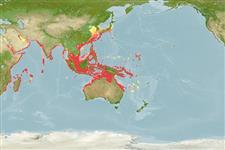Preferred temperature (Ref.
123201): 23.2 - 28.5, mean 27.4 °C (based on 853 cells).
Phylogenetic diversity index (Ref.
82804): PD
50 = 0.5000 [Uniqueness, from 0.5 = low to 2.0 = high].
Bayesian length-weight: a=0.01380 (0.01117 - 0.01706), b=2.98 (2.94 - 3.02), in cm total length, based on LWR estimates for this species (Ref.
93245).
Trofisk nivå (Ref.
69278): 3.5 ±0.3 se; based on diet studies.
Resiliens (Ref.
120179): Låg, lägsta populationsfördubblingstid 4,5-14 år (K=0.2-0.5; tmax=19).
Fishing Vulnerability (Ref.
59153): Low to moderate vulnerability (31 of 100).
🛈
Climate Vulnerability (Ref.
125649): Very high vulnerability (81 of 100).
🛈
Nutrients (Ref.
124155): Calcium = 96.2 [20.9, 182.9] mg/100g; Iron = 0.981 [0.516, 1.813] mg/100g; Protein = 18.9 [17.0, 20.6] %; Omega3 = 0.238 [0.127, 0.403] g/100g; Selenium = 65.1 [37.7, 117.0] μg/100g; VitaminA = 13.5 [6.4, 26.2] μg/100g; Zinc = 1.11 [0.80, 1.56] mg/100g (wet weight);
